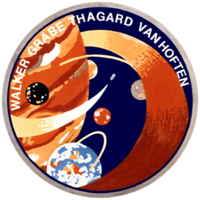| Names | Space Transportation System |
|---|---|
| Mission type | Galileo spacecraft deployment |
| Operator | NASA |
| Mission duration | 4 days, 1 hour, 11 minutes (planned) |
| Spacecraft properties | |
| Spacecraft | Space Shuttle Atlantis (planned) |
| Launch mass | 116,831 kg (257,568 lb) |
| Landing mass | 88,881 kg (195,949 lb) |
| Payload mass | 22,064 kg (48,643 lb) |
| Crew | |
| Crew size | 4 (planned) |
| Members | David M. Walker Ronald J. Grabe Norman E. Thagard James D. A. "OX" van Hoften |
| Start of mission | |
| Launch date | 20 May 1986, 20:21:00 UTC (planned) - Never launched |
| Rocket | Space Shuttle Atlantis |
| Launch site | Kennedy Space Center, LC-39A |
| Contractor | Rockwell International |
| End of mission | |
| Landing date | 24 May 1986, 21:32:00 UTC (planned) |
| Landing site | Kennedy Space Center |
| Orbital parameters | |
| Reference system | Geocentric orbit (planned) |
| Regime | Low Earth orbit |
| Perigee altitude | 298 km (185 mi) |
| Apogee altitude | 307 km (191 mi) |
| Inclination | 34.30° |
| Period | 90.60 minutes |
 STS-61-G mission patch  David M. Walker, Ronald J. Grabe, Norman E. Thagard, James D. A. "OX" van Hoften | |
STS-61-G was a NASA Space Shuttle mission planned to launch on 20 May 1986, using Atlantis. The main objective of this mission was to launch the Galileo spacecraft toward Jupiter using the Centaur-G upper stage. It was canceled after the Space Shuttle Challenger disaster.
YouTube Encyclopedic
-
1/5Views:7 5865073 1388 1855 475
-
Space Shuttle Flight 59 (STS-61) Post Flight Presentation
-
STS 61 Mission Highlights Day 8 Hubble Space Telescope
-
STS-61 Mission Highlights Resource Tape, Part 2
-
STS-2 Mission (40th Anniversary)
-
CNN Coverage of The STS-61-A Launch
Transcription
Crew
| Position | Astronaut | |
|---|---|---|
| Commander | David M. Walker Would have been second spaceflight | |
| Pilot | Ronald J. Grabe Would have been second spaceflight | |
| Mission Specialist 1 | Norman E. Thagard Would have been third spaceflight | |
| Mission Specialist 2 | James D. A. "OX" van Hoften Would have been third spaceflight | |
Crew notes
John M. Fabian was scheduled to fly as Mission Specialist 1 on his third trip to space, but he took advice from his wife who had earlier told him that "his marriage had a two-flight limit", he soon resigned from this mission.[1] His replacement was Norman E. Thagard.[2] Most of the crew sans van Hoften flew on STS-30 in May 1989, with Mary L. Cleave taking the place of van Hoften and the addition of rookie Mark C. Lee. Galileo was launched on STS-34 in October 1989, using the Inertial Upper Stage (IUS) booster instead of the Centaur-G (which was canceled in 1986).
See also
References
- ^ "John M. Fabian, Interviewed by Jennifer Ross-Nazzal, Houston, Texas – 10 February 2006". NASA Johnson Space Center Oral History Project - Edited Oral History Transcript. NASA. 10 February 2006. Retrieved 29 January 2022.
 This article incorporates text from this source, which is in the public domain.
This article incorporates text from this source, which is in the public domain.
- ^ "The new shuttle crews are named". Lodi News-Sentinel. 20 September 1985. Retrieved 29 January 2022.

